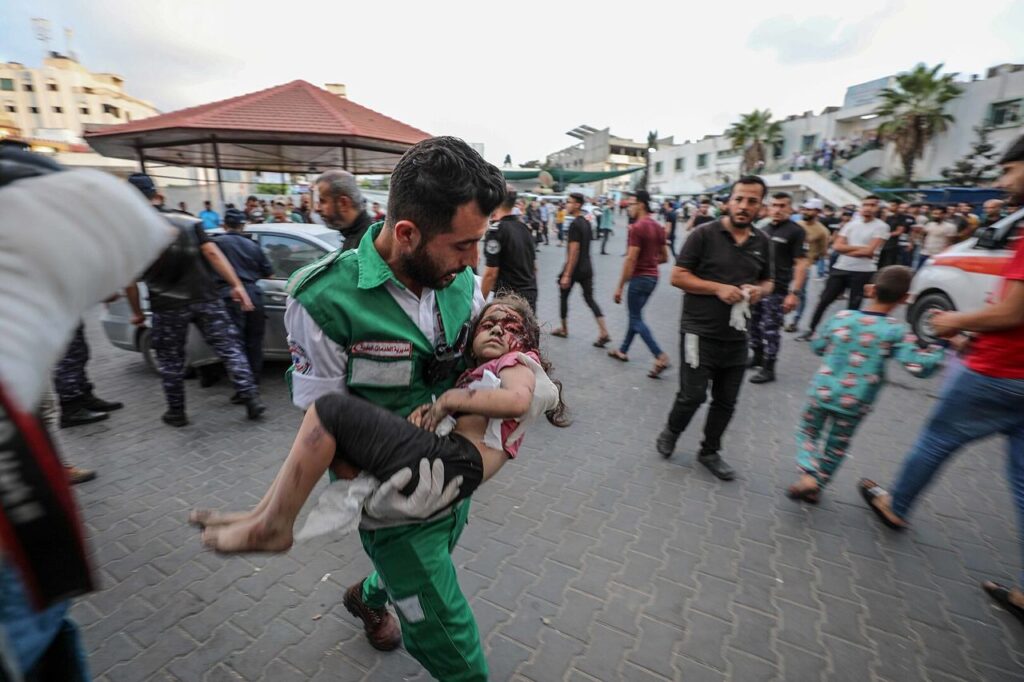As Jews celebrated the biblical holiday Sukkot, Hamas militiamen carried out a terrorist attack that would mark a turning point in history. The Islamist armed wing’s incursion was of an unprecedented calibre: the attack surprised Israelis by land, sea and air. Fourteen hundred Israelis were killed, and the military response has already left more than 9000 Palestinians dead.
The escalation of violence has reached an unprecedented levels. Palestinians in the Gaza Strip are under siege without food, water, electricity or fuel. Hospitals – one of which, Al-Ahli, was bombed – are at a minimum, and there are no safe places left in the entire territory. The Israeli government, under the premise of “wiping out Hamas terrorism”, is carrying out an unprecedented slaughter.
Craig Mokhiber, head of the New York office of the UN High Commissioner for Human Rights, has resigned over the body’s inaction in the face of what he sees as genocide. “I am well aware that the concept of genocide has been abused at the political level, but the current carnage against the Palestinian people […] leaves no room for doubt,” the human rights lawyer wrote in his resignation. UN Secretary General António Guterres declared – after condemning the attacks – that the Hamas incursion “does not come from nothing, but from 56 years of occupation”.
What is António Guterres referring to, and how did the hostilities reach this scale of violence? A review of 20th century history helps us decipher one of the oldest and most complex conflicts in recent history.
The Balfour Declaration, the words that set the tone
“His Majesty’s Government views favourably the establishment in Palestine of a national home for the Jewish people and will use its best endeavours to facilitate the achievement of this objective”.
These words belong to the first document endorsing the birth of Israel, perceived by Jews as a founding landmark and salvation, by Palestinians as occupation and exodus.
On 2 November 1917, the so-called “Balfour Declaration” – named after the then British Foreign Secretary Arthur Balfour – was signed, in which the British government conveyed to Lionel Walter Rothschild, leader of the Jewish community in Britain, its intentions to support the establishment of a Jewish state, a historic claim of Zionism.
When Balfour issued the document, the First World War had already begun three years earlier, and a year after the declaration, the war would end and the Ottoman Empire, to which Palestine belonged, would see the end of its existence.
The victorious Allied powers divided up the lands of the defeated and dissolved empire. Palestine came under the administration of the United Kingdom, i.e. the initiators of the Balfour Declaration. Together with the support of the other countries of the alliance, they then gave their backing to the Zionist political project.
Demography as a battlefield
In 1922, the UN’s predecessor body, the League of Nations, included the Balfour Declaration in the British Mandate over Palestine. Thus the territory that had come under the control of the European power began the process towards the establishment of ‘a national home for the Jewish people’.
Under the British Mandate, Palestinian demographics and idiosyncrasies mutated. Originally the country was 90 percent Arab, as the United Nations notes. In the 1922 census, according to Jewish Virtual Library data, there were about 84,000 Jews in Palestine, 11% of the total population. By 1936, Jewish Virtual Library data put the number of Jews in the territory at 384,000, reaching 28% of the total population. In just 14 years, 300,000 Jews had arrived in Palestine, with a special migratory intensity between 1933 and 1936 due to the fact that many Jewish families were fleeing Nazi persecution, as research by Ghassan Kanafani, Palestinian writer and co-founder of the Popular Front for the Liberation of Palestine – which played a major role in the history of the conflict, as it would eventually become the second most important entity within the Palestine Liberation Organisation (PLO) – points out.
Already in 1935, the economic control exercised by the Jewish community in Palestine was notorious. They controlled 872 of the 1212 industrial enterprises in the region – according to data presented by Kanafani in 1972 for the Committee for Democratic Palestine. This Jewish financial control exceeded four times that in Arab hands. In addition, it is noted that 90 per cent of the concessions granted by the British government were in the hands of the Jewish community. The study also mentions the substantial increase in Jewish rural property from around 30,000 hectares in 1929 to 125,000 hectares in 1930.
All these factors meant that by 1936, with a 28% Jewish population out of the total Palestinian population and strong territorial control, tension led to clashes.
Arab Revolt and the impossibility of coexistence
Tension between communities erupted with the so-called Arab Revolt. The Arab High Committee itself, the political representative of the indigenous population during the British Mandate, called for a general strike. Violence was not long in coming. The repression of the demonstrations increased the hostile tone of the insurrection, to the point of triggering episodes of armed struggle. It was then that a repressive policy that had been a constant feature of the conflict in Palestine was applied for the first time: the demolition of houses.
On the first anniversary of the riots, the London government sent a commission to try to find a way out of the conflict. This commission, known by the name of Lord Peel, who chaired it, came to the conclusion that Jews and Arabs could not live together in peace, thus truncating the ideal of the ‘Jewish national home’. Pedro Brieger, professor of Middle Eastern sociology, explains in his book ‘The Israeli-Palestinian Conflict’ that the Zionist movement acted nimbly, realising the importance of establishing numerous Jewish communities in Palestine in anticipation of future partition. In a process known as the “Joma umig-dal” (one wall and one tower) operation, they purchased land throughout Palestine with the aim of establishing 52 new Jewish settlements. Their strategy was aimed at achieving a demographic majority in the region.
The revolt was put down in 1939, when Palestinian society counted “5000 dead, 10000 wounded and 5697 prisoners. In total, more than 10% of the population was killed, wounded, imprisoned, or went into exile”, as the Orient XXI portal explains. Moreover, research by Eugene Rogan, professor of modern Middle Eastern history at Oxford University, estimates the number of houses demolished in this first application of the repressive policy aimed at forcing displacement, preventing Palestinian population growth and making more land available for the Jewish population in 2000.
The partition proposed by the Peel Commission was closer, and led to the publication of the “White Paper”, a document that proposed elements such as limiting Jewish immigration and stopping the acquisition of land by the Jewish community. The prospect of autonomy and the Palestinian people’s claim to autonomy put the brakes on the Arab Revolt, but no one was entirely satisfied. Especially the Zionist movement, which took this declaration as an infringement of its right under the British mandate.
The tinge of militarisation of Jewish society began to take shape. After the Revolt, the degree of organisation of the Jewish armed groups became more professional and “some 15,000 people were trained in military discipline”, as specified in the “Revista Nómadas, Crítica de Ciencias Sociales y Jurídicas” (Nomadic Journal, Critique of Social and Legal Sciences).
“UN partition plan: a Solomonic decision turned into a catastrophe
The pressure on the British, the administrators of the territory, continued to grow. So much so that the Jewish sector, very unhappy, began to have extremist sectors that committed attacks in Britain. One of them killed the British representative in Palestine. The UK passed the baton of conflict resolution to the UN General Assembly.
The Nazi Holocaust had a profound impact on international public opinion and aroused growing sympathy for the Zionist cause and the creation of a Jewish state in Palestine. The magnitude of the atrocity committed during the Holocaust increased pressure for the establishment of a Jewish state in Palestine, with the aim of providing refuge and self-determination for the survivors of Nazi persecution. In 1947 – two years after the surrender of German troops and the end of World War II – a special UN commission for Palestine passed Resolution 181, better known as the ‘UN Partition Plan’, which provided for the creation of two states with Jerusalem as a ‘neutral territory’ under international control.
The Arabs were unhappy because they felt their right to their own future was violated, in violation of the UN Charter. The Jews were unhappy because they saw their desire to establish the “Jewish national home” in jeopardy.
The UK could not stand the pressure, so in May 1948 it renounced the British Mandate. Without so much as a day’s delay, the Zionists made their move: ‘the leader of the Jewish movement, David Ben Gurion, declared the creation of the State of Israel in accordance with the borders set out in the Partition Plan’, notes the article ‘Partition Plan for Palestine’ in the Institute of International Relations.
Jewish militias began attacking Palestinian villages, leading to an exodus of the indigenous population. The attacks escalated to such an extent that a full-scale war broke out. The Palestinian people recognise this fateful period as the “Nakba” (catastrophe in Arabic): more than half of the Palestinian population was permanently displaced from their homes.

The configuration of “the biggest open-air prison”.
With the self-proclaimed state of Israel and the trauma of the Nakba on the Palestinian population, the forces became increasingly unbalanced. The Zionist movement continued to acquire land and repress the indigenous people in order to win the demographic battle. In the following years, positions continued to be marked on this basis and some 150,000 Palestinians lived under the military occupation of the newborn Israel.
On 5 June 1967, in the course of the Six-Day War against a coalition of Arab armies, Israel took control of what remained of historic Palestine, encompassing the Gaza Strip, the West Bank, East Jerusalem, the Syrian Golan Heights and Egypt’s Sinai Peninsula.
The ‘Naksa’ (Arabic for ‘setback’) was the result, with the Palestinian population subjected to further mass displacement. Discrimination against Arabs meant that the military occupation repressed their forms of political expression, yet Israelis lived with all the advantages of being citizens of the new state.
It was then that the notorious Gaza Strip began to become, by its self-proclaimed motto, “the largest open-air prison”. With strict military controls, the Strip began the process of establishing itself as a Palestinian ghetto in the already occupied Palestine.
Prior to the Naksa, in 1964, the Palestine Liberation Organisation (PLO) was born. The coalition of political and paramilitary movements emerged as the armed wing of the Palestinian struggle and proved crucial: from October 1974, the Arab League recognised the PLO as the sole legitimate representative entity of the Palestinian people.
This endorsement translated into international recognition, as in the same year the United Nations General Assembly granted the PLO observer status, consolidating its role in the global arena as the official voice of the Palestinian people. This took place in a complex context: shortly before, between 6 and 25 October 1973, a major military confrontation had broken out.
The Yom Kippur War, also known as the Ramadan War, pitted Israel against a coalition of Arab nations, led mainly by Egypt and Syria. The conflict took its name from the holiest day in the Jewish calendar, the Day of Atonement or Yom Kippur, when Arab belligerents launched surprise attacks in an attempt to regain territory lost to Israel during the Six Day War in 1967.
Although the border changes were not drastic, the Yom Kippur War left an indelible mark on regional politics. Its repercussions led to a series of subsequent negotiations in search of peace agreements.
First Intifada, the confrontation of stones against tanks
An accident between an Israeli truck and a Palestinian car – whose occupants were killed – triggered a new tragedy in October 1987. It marked the beginning of the first intifada: Palestinian youths armed with stones against Israeli tanks. As the book “The Routledge Handbook on the Israeli-Palestinian conflict” explains, the clash of the vehicles was only the last spark of something much bigger: “The cumulative effect of decades of asymmetrical military forces, defeats, land expropriations, poverty and occupation were the breeding ground for a revolution”, it says of the First Intifada. The protests spread quickly and reached the West Bank. On the first anniversary of the intifada, in 1988, the PLO – led by Yasser Arafat – declared Palestinian independence with a government in exile.
Stones against tanks symbolise the asymmetry, and the five-year uprisings resulted in more than 1,300 Palestinian deaths and a harsh repressive policy by the Israeli army, led by then Defence Minister Yitzhak Rabin. Protesters were subjected to summary executions, broken bones and all kinds of torture, according to various testimonies reported by Al Jazeera. During the first intifada, the Hamas movement, an offshoot of the Muslim Brotherhood, was born and took part in the confrontation as an armed actor.
A mirage of peace with the Oslo Accords
Far from Palestine, rapprochement began to take shape. From 1993 to 1995, unprecedented agreements were negotiated in Norway: peace could become a reality. Yasser Arafat, leader of the PLO, and Yitzhak Rabin, then prime minister of the Israeli government, recognised each other as interlocutors in the search for a resolution. The talks resulted in the landmark Oslo Accords.
In the Oslo Accords, Rabin agreed to return the West Bank and Gaza, rolling back the military occupation. For his part, Arafat agreed to recognise the Israeli people. The Agreements resulted in the formation of the Palestinian Authority (PA), a self-governing model for the management of the territories and military withdrawal.
But the conflict carried too large a burden. It was rooted in religion, in society, in ways of life, in the imagination of the people. Its complexity squandered the Accords: diplomatic resolution and social approval did not go hand in hand. Within Zionism itself, disparate positions were generated, and the most extreme among them killed Rabin, who was seen by them as a kind of “traitor”.
With the assassination of the Israeli power figure who had signed the Accords, an uncertain scenario opened up. The ensuing elections in 1996 gave victory to Benjamin Netanyahu. He represented the sector most hostile to the Oslo Accords, and so the failure that had been predicted came. Israel suspended the commitments and sowed the seeds of a Palestinian state.
The Failure of the Accords and the Second Intifada
It was against this backdrop that a second intifada broke out. This time the trigger was the visit in 2000 of the leader of Likud – Israel’s right-wing party – to the Al-Aqsa Mosque in Jerusalem – a controversial site since its control was disputed after the failed peace negotiations. For Palestinians, it was an act of provocation. Protests and clashes returned.
The policy of house demolitions, a constant in the development of the conflict, was once again very present: Amnesty International in a 1999 report denounced this practice, which was committed systematically and with impunity. The population evicted without warning was forced to move as the Zionist movement gained ground: settlements were again erected in areas under the control of the Palestinian Authority. The Palestinian economy and infrastructure were particularly affected during the uprisings, which ended in 2005: the year before, Yasser Arafat, the driving force behind the Oslo Accords, died.
For the first time, Palestinians voted in general elections. But the conflict became so entrenched that it affected the internal dynamics themselves. War broke out between Hamas – the Muslim Brotherhood offshoot of the first intifada – and Fatah – the political-military organisation founded by the late Yasser Arafat and integrated into the PLO. The partition of Palestine itself became a reality: Hamas drove Fatah out of the Strip, and Fatah – the main party of the Palestinian Authority – took control of parts of the West Bank.
21st century, the cycle of successive Gaza wars
After branding Hamas as terrorist, Israel found the premise in 2007 to impose a total blockade on the Gaza Strip. Since then, hostilities in the area have been constant.
In 2008 the Israeli Defence Forces (IDF) launched ‘Operation Cast Lead’: bombings that left at least 1300 Palestinians dead. It is estimated that more than half were civilians. The Israeli army used white phosphorus, a highly harmful chemical that violates humanitarian law.
Four years later, in 2012, came another Israeli offensive, “Operation Pillar of Defence”. More than a hundred civilians were killed. 2014 was the year of “Operation Protective Edge”, where 2205 Palestinians – with more than 1500 civilians – were killed. The last major IDF military attack before the events of 2023 was in 2021, “Sword of Jerusalem”, with a total of more than 200 killed.
Hamas’s attack on Israel on 7 October 2023 would be the trigger for a new cycle of violence, this time with a particularly catastrophic prognosis. “We are fighting human animals and we act accordingly,” said Yoav Gallant, Israel’s defence minister. The death toll will continue to rise on its way to genocide.



